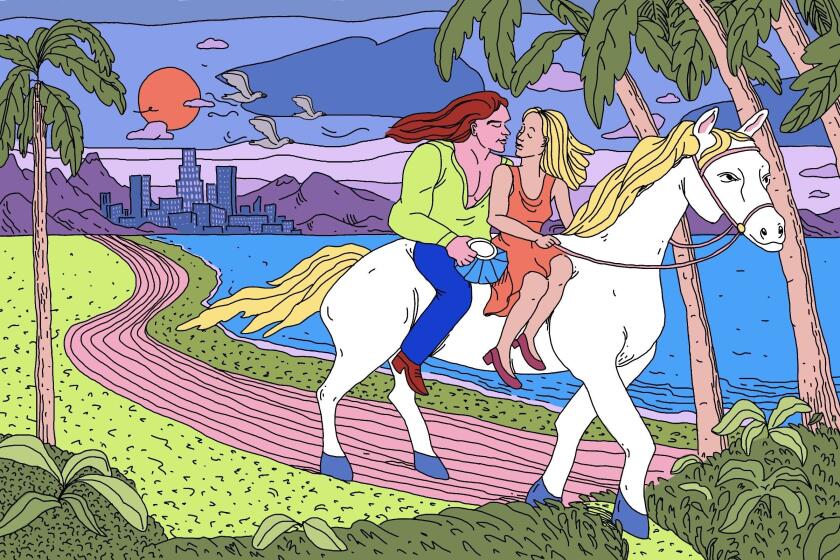Colony in Pacific Palisades nurtured top artists in 1950s, 1960s
When times are good, artists and writers get the support they need, enriching city life in unquantifiable ways. But when the economy heads south or the rich lose interest, artists are among the first to suffer. Today we’re hearing predictions of fewer movies, fewer books and fewer plays. In the case of L.A.’s Museum of Contemporary Art, there will be fewer exhibitions to support new work just when we need creative thinking.
Of course, artists have had it rough for centuries, their livelihoods vulnerable to the whims of the powerful. Writers, painters, musicians -- they began as courtiers to Renaissance princes but ended as outcasts in 19th century industrial cities. Think of Ewan McGregor in “Moulin Rouge!,” living the not-so-romantic vie bohème in a Parisian garret. It was then that art colonies took off, abroad and in America. From Cornish, N.H., to La Jolla, Calif., artists formed rural retreats to take care of their own on the cheap. The tradition was well established when supermarket millionaire Huntington Hartford stepped up to the plate right here in L.A.
Hartford is infamous for his 1964 Gallery of Modern Art on New York’s Columbus Circle -- reopened in 2008 as the Museum of Arts and Design. An L.A. resident, Hartford built his gallery after the Los Angeles County Museum of Art rejected an exhibition he proposed. Hartford decided that building a museum in L.A. was like putting up “a theater in Oklahoma” -- no matter how great the building, there wouldn’t be an audience.
Hartford wasn’t always a turncoat. In 1948, he bought up more than 150 acres in Pacific Palisades’ Rustic Canyon and hired architect Lloyd Wright. Wright adapted existing buildings and designed from scratch two duplexes, one for painters and one for writers, with living quarters and studios. When the colony finally got going in 1951, it had more than a dozen cottages and a central dining room for distinguished artists, composers and craftspeople who won scholarships for one- to six-month retreats.
Their successes were international and led to Pulitzer Prizes and exhibitions, concerts and theater performances. Sam Kaner made glass mosaics, Ernst Toch composed his “Vanity of Vanities,” naturalist Charles Neider worked on his anthology “The Fabulous Insects” and Ruth S. Wylie polished her String Quartet No. 3. Radical essayist Max Eastman came, and so did Edward Hopper, who finished his painting “Western Motel” while a resident in 1957. National advisors to Hartford and to the colony director, UCLA composer and Arnold Schoenberg disciple John Vincent, were impressive: journalist Norman Cousins, conductor and composer Leonard Bernstein and painters Charles Burchfield and Thomas Hart Benton.
But it wasn’t all paradise up in the hills. It never is for the artist. No overnight guests or children could be invited, and phone calls were limited to three minutes. Smoking was verboten. Cars were not allowed; a driver took colonists to town in a Studebaker wagon. The philosophizing of Hartford guided the selection of artists and the colony’s staff. He thought the Abstract Expressionists had ushered in a great “ice age of art,” freezing out the grand traditions of music, painting and sculpture. He resented the rise of the powerhouse art gallery. Picasso was a “mountebank”; dealer Sidney Janis, playwright Tennessee Williams, poet T.S. Eliot and painter Willem de Kooning were evil.
In Hartford’s words, the “beatnik, the Existentialist, the juvenile delinquent, the zaniest of abstract art, the weird- est aberrations of the mentally unbalanced, the do-nothing philosophy of Zen Buddhism” resulted from a renegade “abuse of liberty and freedom.”
As one critic remarked, Hartford had “plenty of prejudices but none of them literate.” What he liked was moral and what he didn’t like was immoral; the artists in Hartford’s bohemian getaway were there to prove him right.
For about 15 years, with free food and shelter, more than 400 colony artists invigorated culture in Los Angeles. But then Hartford tired of footing the bills. He asked government officials and wealthy patrons to contribute. Self-professed art lover and UCLA Chancellor Franklin Murphy, the Broadway department store President Edward M. Carter, L.A. Mayor Sam Yorty and Martin Dibner at the California Arts Commission were magnanimous with vocal support, but cash never came.
In 1965, disgusted and on the hook for his New York museum, Hartford closed the colony, donated its Studebaker to LACMA and left the artists in L.A. to fend for themselves. As for their studios, they were reduced to rubble by the state after it acquired the land in 1971 as part of Topanga State Park.
Watters is author of “Los Angeles Houses, 1885-1935.”
His columns are archived at latimes.com/lostla.
More to Read
Sign up for our L.A. Times Plants newsletter
At the start of each month, get a roundup of upcoming plant-related activities and events in Southern California, along with links to tips and articles you may have missed.
You may occasionally receive promotional content from the Los Angeles Times.






